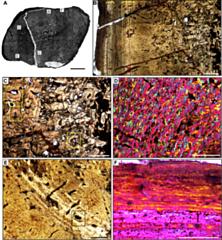Project 4515: K. Curry Rogers, R. N. Martinez, C. Colombi, R. R. Rogers, O. Alcober. 2024. Osteohistological insight into the growth dynamics of early dinosaurs and their contemporaries. PLOS ONE. 19 (4):e0298242.

Specimen: † Exaretodon argentinus (PVSJ:38-2002)
View: Histology Mid-Diaphysis Cross Section
View: Histology Mid-Diaphysis Cross Section
Abstract
Dinosauria debuted on Earth’s stage in the aftermath of the Permo-Triassic Mass Extinction Event, and survived two other Triassic extinction intervals to eventually dominate terrestrial ecosystems. More than 231 million years ago, in the Upper Triassic Ischigualasto Formation of west-central Argentina, dinosaurs were just getting warmed up. At this time, dinosaurs represented a minor fraction of ecosystem diversity. Members of other tetrapod clades, including synapsids and pseudosuchians, shared convergently evolved features related to locomotion, feeding, respiration, and metabolism and could have risen to later dominance. However, it was Dinosauria that radiated in the later Mesozoic most significantly in terms of body size, diversity, and global distribution. Elevated growth rates are one of the adaptations that set later Mesozoic dinosaurs apart, particularly from their contemporary crocodilian and mammalian compatriots. When did the elevated growth rates of dinosaurs first evolve? How did the growth strategies of the earliest known dinosaurs compare with those of other tetrapods in their ecosystems? We studied femoral bone histology of an array of early dinosaurs alongside that of non-dinosaurian contemporaries from the Ischigualasto Formation in order to test whether the oldest known dinosaurs exhibited novel growth strategies. Our results indicate that the Ischigualasto vertebrate fauna collectively exhibits relatively high growth rates. Dinosaurs are among the fastest growing taxa in the sample, but they occupied this niche alongside crocodylomorphs, archosauriformes, and large-bodied pseudosuchians. Interestingly, these dinosaurs grew at least as quickly, but more continuously than sauropodomorph and theropod dinosaurs of the later Mesozoic. These data suggest that, while elevated growth rates were ancestral for Dinosauria and likely played a significant role in dinosaurs’ ascent within Mesozoic ecosystems, they did not set them apart from their contemporaries.Read the article »
Article DOI: 10.1371/journal.pone.0298242
Project DOI: 10.7934/P4515, http://dx.doi.org/10.7934/P4515
| This project contains |
|---|
Download Project SDD File |
Currently Viewing:
MorphoBank Project 4515
MorphoBank Project 4515
- Creation Date:
05 January 2023 - Publication Date:
15 February 2024 - Media downloads: 34

This research
supported by
Authors' Institutions ![]()
- Universidad Nacional de San Juan
- Macalester College
Members
| member name | taxa |
specimens |
media |
| Kristi Curry Rogers Project Administrator | 12 | 11 | 10 |
Project has no matrices defined.
Project downloads 
| type | number of downloads | Individual items downloaded (where applicable) |
| Total downloads from project | 39 | |
| Project downloads | 5 | |
| Media downloads | 34 | M890549 (3 downloads); M902010 (5 downloads); M902011 (4 downloads); M902012 (3 downloads); M902013 (2 downloads); M902015 (3 downloads); M902016 (3 downloads); M902017 (3 downloads); M902018 (4 downloads); M902014 (4 downloads); |
